- Zephyranthes Care
- Light
- Watering
- Temperature and Humidity
- Soil
- Fertilizer
- Propagation
- Pests and Diseases
- Zephyranthes Photos
- Zephyranthes Species
- Zephyranthes candida
- Zephyranthes grandiflora
- Zephyranthes rosea
- Zephyranthes carinata
- Zephyranthes chlorosolen
- Growing Zephyranthes Indoors
- Choosing the Right Pot
- Soil Requirements
- Light and Temperature
- Watering and Humidity
- Fertilizing
- Propagation
- Common Problems
- Conclusion
- Zephyranthes Propagation
- 1. Division
- 2. Bulbils
- 3. Seeds
- 4. Tissue culture
- Zephyranthes Problems
- Zephyranthes Benefits
- Q&A:
- How often should I water Zephyranthes?
- What is the best location for growing Zephyranthes plants?
- How do I propagate Zephyranthes?
- Are Zephyranthes plants toxic to pets?
- Can I grow Zephyranthes from seeds?
- What are some common pests and diseases that affect Zephyranthes plants?
- Video: How to grow rain lilies from seeds | How to propagate rain lily from seeds
Zephyranthes, also known as the Fairy Lily or Rain Lily, is a genus of flowering plants in the Amaryllidaceae family. Native to the Americas, these beautiful and delicate flowers are known for their vibrant colors and late summer to early fall blooming period.
With over 70 species, Zephyranthes has a wide variety of flowers to choose from. Some of the most popular species include Zephyranthes candida, Zephyranthes grandiflora, and Zephyranthes rosea. Each species has its own unique characteristics and care requirements, making them a popular choice for both beginner and experienced gardeners.
When it comes to caring for Zephyranthes, proper watering is key. These plants prefer moist soil, but they do not like to be waterlogged. It is important to water them regularly during the growing season, but allow the soil to dry out slightly between waterings. Additionally, Zephyranthes thrive in full sun to partial shade, making them a versatile addition to any garden or indoor space.
Whether you’re a seasoned gardener or just starting out, Zephyranthes is a beautiful and easy-to-care-for flower that will brighten up any space. With their vibrant colors and unique blooming period, these flowers are sure to impress. So why not give Zephyranthes a try and enjoy the beauty they bring to your garden or home?
“Zephyranthes, also known as the Fairy Lily or Rain Lily, is a genus of flowering plants in the Amaryllidaceae family.”
Zephyranthes Care
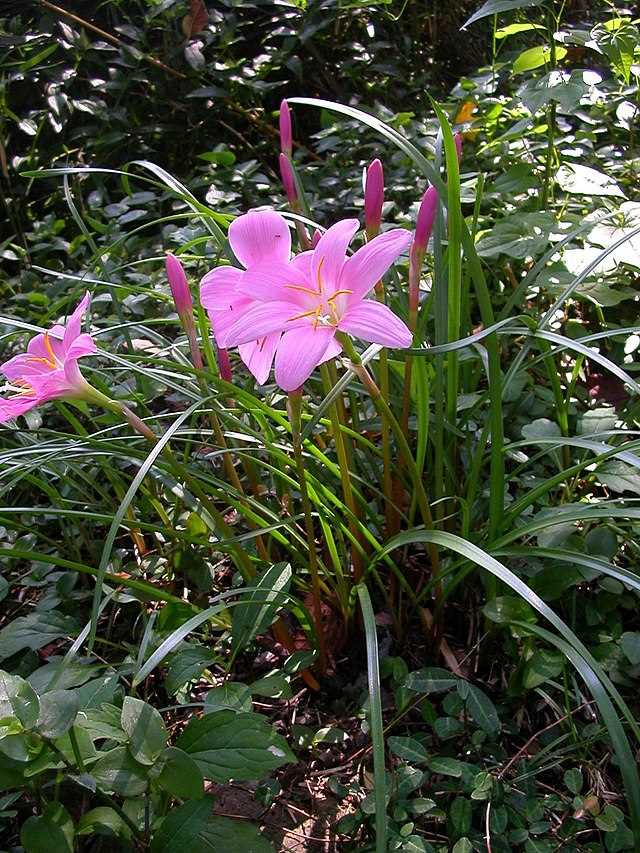
Zephyranthes, also known as Rain Lilies, are beautiful flowering plants that can add a pop of color to any garden or indoor space. With the right care, these plants can thrive and produce stunning blooms. Here are some tips to help you care for your Zephyranthes:
Light
Zephyranthes plants prefer bright, indirect light. They can tolerate some direct sunlight, especially in the morning or late afternoon, but too much direct sun can burn their leaves. If you are growing Zephyranthes indoors, place them near a window where they can receive bright, filtered light.
Watering
Proper watering is crucial for the health of Zephyranthes. During the growing season, water your plants regularly, keeping the soil evenly moist. However, be careful not to overwater, as this can lead to root rot. Allow the top inch of soil to dry out slightly between waterings. In the dormant season, reduce watering and allow the soil to dry out more between waterings.
Temperature and Humidity
Zephyranthes plants prefer moderate temperatures between 60°F and 75°F (15°C to 24°C). They can tolerate slightly cooler temperatures, but avoid exposing them to frost. As for humidity, they can tolerate average room humidity, but appreciate a slightly higher humidity level. You can increase humidity by placing a tray of water near the plant or using a humidifier.
Soil
Zephyranthes prefer well-draining soil that is rich in organic matter. A mix of peat moss, perlite, and compost works well for these plants. Avoid compacted or heavy soils that can retain too much moisture. You can also add some sand to improve drainage.
Fertilizer
Feed your Zephyranthes plants with a balanced, water-soluble fertilizer during the growing season. Apply the fertilizer once every two weeks at half the recommended strength. Avoid fertilizing in the dormant season.
Propagation
Zephyranthes plants can be propagated through division or from seeds. Divisions should be done in the spring, while seeds can be sown in the fall or early spring. To divide the plant, carefully remove it from its pot and separate the bulbs. Plant the divisions in separate pots or in the garden, making sure to keep the soil moist until they establish roots.
Pests and Diseases
Zephyranthes plants are generally healthy and not prone to many pests or diseases. However, they can occasionally be affected by aphids, spider mites, or fungal diseases. Regularly inspect your plants for any signs of pests or diseases, and treat them promptly if necessary.
By following these care tips, you can enjoy the beauty of Zephyranthes plants and their charming raindrop-like flowers in your garden or home.
Zephyranthes Photos
Here are some beautiful photos of Zephyranthes. These photos showcase the stunning blooms and vibrant colors of this flower.
- Photo 1: This photo shows a close-up of a Zephyranthes flower in full bloom. The petals are a bright shade of yellow, with a beautiful star-shaped pattern in the center.
- Photo 2: In this photo, you can see a group of Zephyranthes flowers growing together in a garden. The flowers come in various shades of white, yellow, and pink, creating a visually striking display.
- Photo 3: This photo captures a Zephyranthes flower after a rain shower. The raindrops on the petals add an extra layer of beauty to the already stunning flower.
- Photo 4: Here is a close-up of a Zephyranthes flower bud just before it blooms. The soft pink color and delicate shape of the bud hold the promise of a gorgeous flower.
Zephyranthes is truly a flower that can brighten up any garden or floral arrangement. Its vibrant colors and lovely blooms make it a favorite among garden enthusiasts and flower lovers.
Zephyranthes Species
Zephyranthes is a genus of flowering plants in the Amaryllis family, native to the Americas. There are approximately 70 recognized species in this genus, with new ones being discovered and named regularly. Here are some notable Zephyranthes species:
Zephyranthes candida
Also known as the “White Rain Lily,” Zephyranthes candida is one of the most widely grown species of Zephyranthes. It produces beautiful white flowers that bloom after rainfall or when well-watered.
Zephyranthes grandiflora
Also referred to as the “Golden Rain Lily,” Zephyranthes grandiflora is native to South America. It features showy yellow flowers and is known for its ability to withstand drier conditions compared to other Zephyranthes species.
Zephyranthes rosea
Commonly known as the “Pink Rain Lily,” Zephyranthes rosea is native to Brazil and Uruguay. It produces delicate pink flowers that are often used in floral arrangements and landscaping.
Zephyranthes carinata
The “Flaming Lily” or Zephyranthes carinata is native to Mexico and Central America. It has striking red, trumpet-shaped flowers and prefers warmer climates.
Zephyranthes chlorosolen
Native to Brazil, Zephyranthes chlorosolen is known for its bright green flowers. It is a unique species within the Zephyranthes genus and makes an interesting addition to any collection.
These are just a few examples of the many Zephyranthes species that exist. Each species has its own unique characteristics and requirements, making them fascinating plants to grow and study.
References:
Growing Zephyranthes Indoors
Zephyranthes, also known as rain lilies, are beautiful flowering plants that can be grown indoors. These plants are native to tropical and subtropical regions and are loved for their delicate flowers that bloom after rainfall. Growing Zephyranthes indoors can be a rewarding experience, as they bring a touch of beauty and freshness to any indoor space.
Choosing the Right Pot
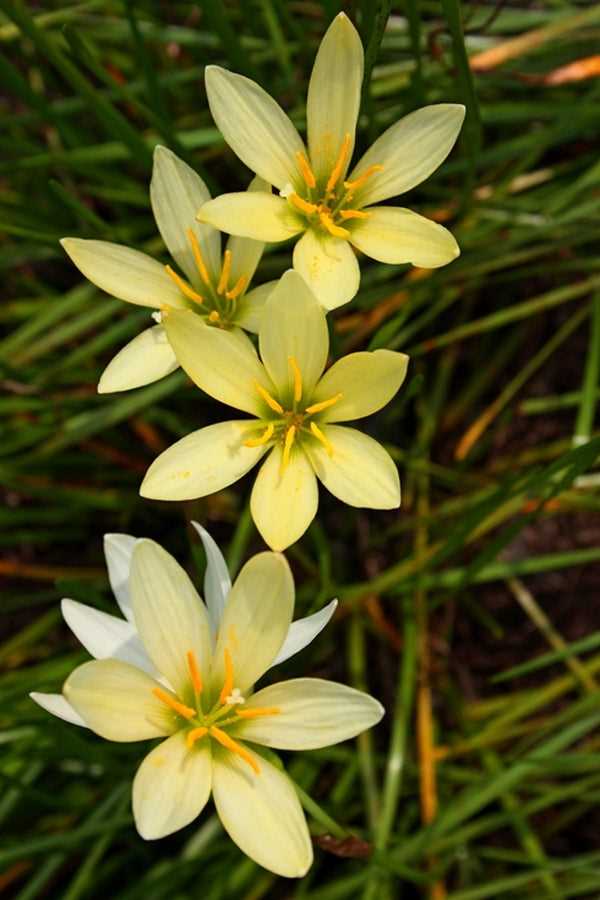
When growing Zephyranthes indoors, it’s important to choose the right pot. A pot with drainage holes is essential to ensure proper water drainage and prevent root rot. The pot should also be deep enough to accommodate the plant’s bulb and allow room for growth.
Soil Requirements
Zephyranthes prefers well-draining soil. A mixture of regular potting soil and perlite or sand can provide the ideal growing medium for these plants. This type of soil allows excess water to drain away from the roots, preventing waterlogged conditions and root rot.
Light and Temperature
Zephyranthes thrives in bright, indirect light. Placing the plant near a window or providing it with artificial grow lights can ensure it receives enough light for healthy growth. These plants prefer temperatures between 60-80°F (15-27°C), making them suitable for most indoor environments.
Watering and Humidity
Water Zephyranthes thoroughly when the top inch of soil feels dry. Allow the excess water to drain away, and never let the plant sit in a saucer of water. These plants prefer slightly higher humidity levels, so misting the leaves regularly or placing a tray of water near the plant can create a more humid environment.
Fertilizing
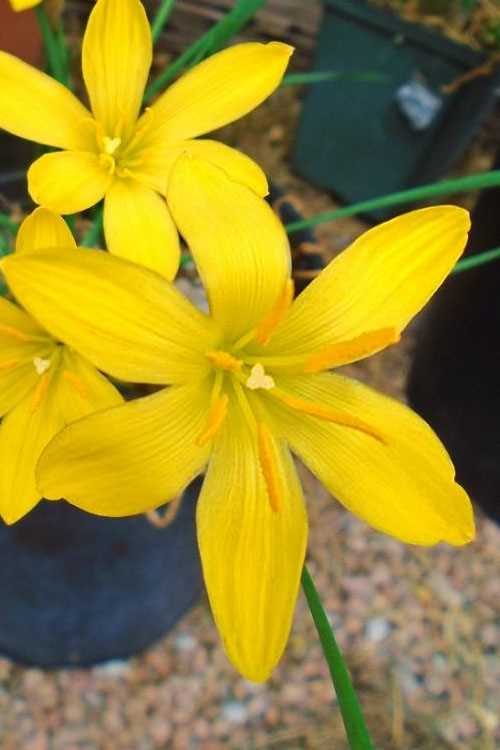
Zephyranthes benefit from regular fertilization during the growing season. Use a balanced, water-soluble fertilizer and follow the manufacturer’s instructions for dosage and frequency. Avoid over-fertilization, as it can lead to leaf burn and other problems.
Propagation
Zephyranthes can be propagated by dividing the bulbs. Carefully separate the bulbs, ensuring each division has at least one healthy bulb and some roots. Plant the divisions in a suitable potting mix and water thoroughly. With proper care, the divisions will establish themselves and produce new growth.
Common Problems
Some common problems that can affect Zephyranthes include fungal diseases, such as leaf spot and bulb rot. These can be prevented by providing proper air circulation, avoiding over-watering, and using well-draining soil. Pests, such as aphids and mealybugs, can also infest Zephyranthes. Regular inspection and using organic pest control methods can help keep these pests at bay.
Conclusion
Growing Zephyranthes indoors can be a delightful experience. By providing the right conditions, such as proper lighting, well-draining soil, and adequate watering, these plants can thrive and bloom beautifully. With a little care and attention, you can enjoy the graceful charm of Zephyranthes flowers in your indoor space.
Zephyranthes Propagation
Zephyranthes, also known as rain lilies, can be propagated through various methods depending on the species. Here are some common propagation techniques:
1. Division
Most Zephyranthes species can be propagated by division. Dig up the clump of bulbs and carefully separate them into smaller clusters. Each cluster should have a few bulbs attached. Replant the clusters in well-draining soil and water thoroughly.
2. Bulbils
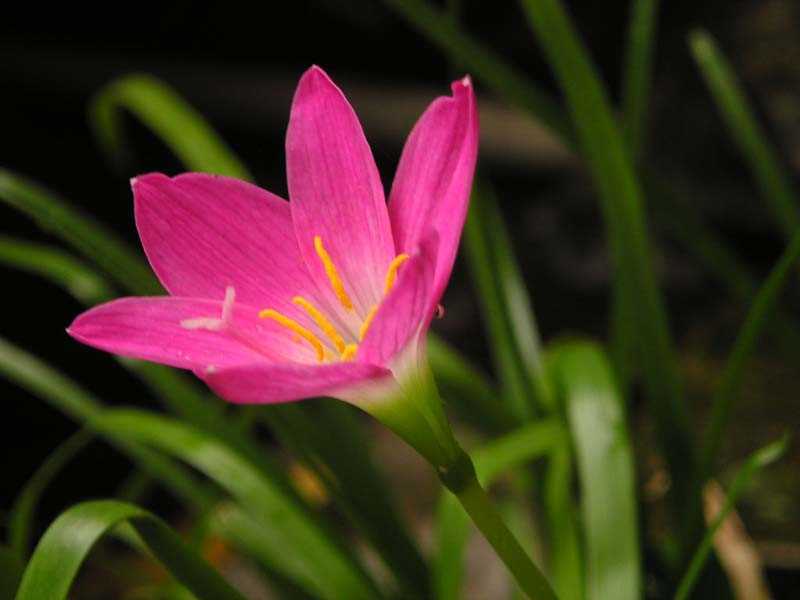
Some Zephyranthes species produce small bulbils around the base of the parent bulb. Gently remove these bulbils and plant them in a separate container or directly in the garden. Make sure to provide them with well-draining soil and adequate moisture.
3. Seeds
Zephyranthes seeds can be collected from mature flowers and sown in a seed-starting mix. Sow the seeds at a depth of about 1/4 inch and keep the soil consistently moist. Germination usually takes several weeks to a couple of months.
4. Tissue culture
For rare or hard-to-propagate Zephyranthes species, tissue culture can be used to propagate large numbers of plants from a small piece of tissue. This method requires specialized equipment, knowledge, and sterile conditions and is typically done by experienced growers or nurseries.
Regardless of the propagation method used, it’s important to provide the newly propagated Zephyranthes plants with the right growing conditions, including bright light, well-draining soil, and regular watering. With proper care, the new plants will develop into beautiful rain lilies.
Zephyranthes Problems
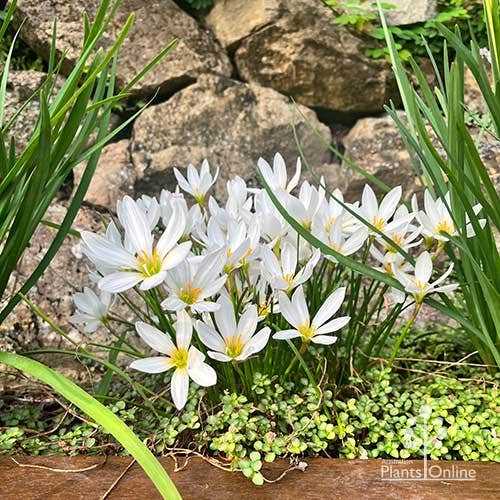
Despite their overall hardiness, Zephyranthes plants can encounter some problems that may affect their health and growth. Here are some common issues to be aware of:
- Fungal Diseases: Zephyranthes plants are susceptible to fungal diseases such as gray mold and root rot. These diseases are often caused by overwatering or poor water drainage. To prevent fungal infections, ensure that the soil is well-draining and avoid overwatering. If you notice any signs of fungal disease, such as wilting or discolored leaves, treat the plant with a suitable fungicide.
- Insect Pests: Zephyranthes plants may attract common garden pests such as aphids, mealybugs, or thrips. These pests can cause damage by feeding on the leaves and sap of the plants. To control insect pests, regularly inspect your plants for signs of infestation and use appropriate insecticides or natural remedies, such as neem oil, to eliminate them.
- Nutrient Deficiencies: Zephyranthes plants require adequate nutrition to grow and flower properly. Lack of essential nutrients, such as nitrogen, phosphorus, or potassium, can result in stunted growth, yellowing leaves, or poor flowering. Fertilize your Zephyranthes plants regularly with a balanced fertilizer to provide them with the necessary nutrients.
- Overcrowding: Zephyranthes plants prefer to have some space around them. If they are planted too closely together, they may become overcrowded, which can lead to competition for resources and poor growth. Make sure to give each plant enough room to grow and spread out.
- Extreme Temperatures: While Zephyranthes plants are generally hardy, they can be sensitive to extreme temperatures. Frost or prolonged exposure to high temperatures can damage the plants and inhibit their growth. Protect the plants from extreme weather conditions by providing them with appropriate shelter or by bringing them indoors during extreme cold or heat.
- Improper Dormancy Period: Zephyranthes plants have a dormant period during which they require a period of rest. If this dormancy period is not provided, the plants may struggle to flower or exhibit poor growth. To ensure proper dormancy, gradually reduce the amount of water and fertilizer given to the plants during the winter months.
By being aware of these potential problems and taking appropriate measures, you can help your Zephyranthes plants thrive and enjoy their beautiful flowers.
Zephyranthes Benefits
Zephyranthes, also known as rain lilies, offer several benefits to gardeners and plant enthusiasts. Here are some of the key advantages of growing Zephyranthes:
- Drought Tolerance: Zephyranthes plants are highly drought-tolerant, making them ideal for regions with limited water availability. They can survive and bloom even in dry conditions, requiring minimal watering.
- Easy to Grow: These plants are relatively easy to grow and care for. They don’t demand a lot of attention and can thrive in a variety of soil types. Zephyranthes are suitable for both experienced gardeners and beginners.
- Beautiful Blooms: One of the main attractions of Zephyranthes is their stunning and vibrant flowers. These plants produce delicate, trumpet-shaped flowers in various colors, including shades of white, pink, yellow, and orange. The colorful blooms add a burst of beauty to any garden or landscape.
- Long Blooming Period: Zephyranthes have a long blooming period, often lasting for several weeks. This extended flowering duration provides a prolonged display of color in the garden or flower bed.
- Naturalization: Zephyranthes has the ability to naturalize rapidly in the garden, spreading and forming clusters of plants. As they reproduce, they can quickly fill in empty spaces, creating a carpet of beautiful blooms.
- Low Maintenance: These plants require minimal maintenance once established. They don’t need frequent pruning or fertilization, and pests and diseases rarely bother them. Zephyranthes are a great choice for those seeking low-maintenance plants.
In summary, growing Zephyranthes can bring many advantages to gardeners, including their ability to thrive in drought conditions, ease of cultivation, stunning blooms, extended flowering period, naturalization, and low maintenance requirements.
Q&A:
How often should I water Zephyranthes?
Zephyranthes plants prefer to be kept evenly moist, so water them regularly, especially during the growing season. Water when the top inch of soil feels dry, but do not overwater as it can lead to root rot.
What is the best location for growing Zephyranthes plants?
Zephyranthes plants thrive in bright, indirect light conditions. They are ideal for growing indoors near a sunny window or outdoors in a spot that receives partial shade. Avoid placing them in direct sunlight as it can scorch the foliage.
How do I propagate Zephyranthes?
Zephyranthes can be propagated through division or by planting their bulbs. To divide the plant, carefully separate the clumps in early spring and replant them in well-draining soil. To propagate by bulb planting, bury the bulbs about 2-3 inches deep in the soil and keep them moist until they establish roots.
Are Zephyranthes plants toxic to pets?
Zephyranthes plants are not known to be toxic to pets, but it is always a good idea to keep them out of reach of curious animals. If ingested in large quantities, the plant may cause gastrointestinal upset, so it is best to monitor your pets’ interactions with the plant.
Can I grow Zephyranthes from seeds?
Yes, it is possible to grow Zephyranthes from seeds, but it may take longer for them to flower compared to propagating through bulbs or division. Sow the seeds in well-draining soil, keep them consistently moist, and provide them with bright, indirect light. It may take several years for the plants to reach maturity and produce flowers.
What are some common pests and diseases that affect Zephyranthes plants?
Some common pests that can affect Zephyranthes plants include aphids, spider mites, and mealybugs. These can be treated with insecticidal soaps or horticultural oils. Diseases such as root rot can occur if the plants are overwatered or if they are grown in poorly draining soil. It is important to ensure the plants are in well-draining soil and not watered excessively.
Video:
How to grow rain lilies from seeds | How to propagate rain lily from seeds







